Like many creative people, I struggle with getting things done. Motivating myself to actually sit down and write the next page of my novel, or work on the outline, or read the next chapter of that book I said I was going to read… Somehow, despite having all these “things” I “want” to “do,” when the moment comes, it’s always easier to keep browsing the web for just a few more minutes hours days, or to suddenly realize I need to reorganize my entire hard drive.
This post isn’t to teach you how to overcome your own procrastination. There are countless self-help books for those things. This post is just about the strategies I’ve used over the years to track my own productivity—the successes, the failures, and everything in between.
(If you are looking for some self-help advice, I’ve read and recommend each of those articles/books linked above. They’re all great and full of great advice.)
(I don’t follow any of their advice, though, because I’m dense and stubborn and bad with change.)
Anyway, here’s a brief history of my productivity tracking methods.
The Accomplishments 2012.docx Era
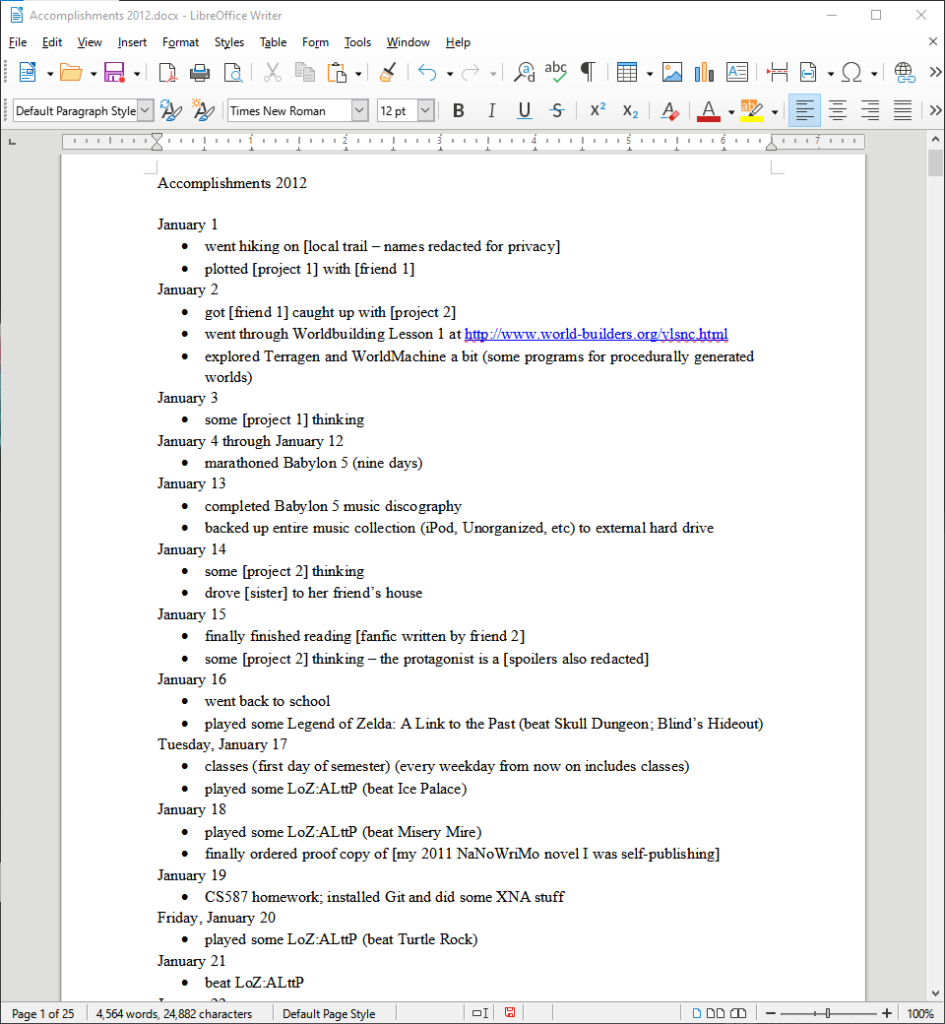
My first vague attempt at productivity tracking came in the form of a Microsoft Word doc: Accomplishments 2012.docx, a file in which I wrote down my major “accomplishments” every day. The goal was to track the most important thing I did every day, to get myself to constantly answer the question, “what did I do today that made today matter?”
In retrospect, the productivity tracking was kind of incidental—as you can see from the screenshot above, a lot of what I recorded was not work on creative projects… which means there were a lot of days that I didn’t work on creative projects at all, because when I did, that was almost always the major “accomplishment” of the day. (Jeez, look at how little I did in that entire month. No writing, just a lot of “thinking” about my stories. Yikes!)
It was accomplishment tracking in its purest, most basic form: if I did something I thought was worthy of being called an accomplishment, I tracked it. No goals to work toward, no deadlines to keep, nothing at all to help keep me going in the right direction—except maybe the vague threat of guilt if I realized I was going too long without doing anything of “value.” But somehow, I was able to keep the tracking habit going with daily updates for the entire year.
The next year, I started Accomplishments 2013.docx and refined my process by adding some goals for the year:
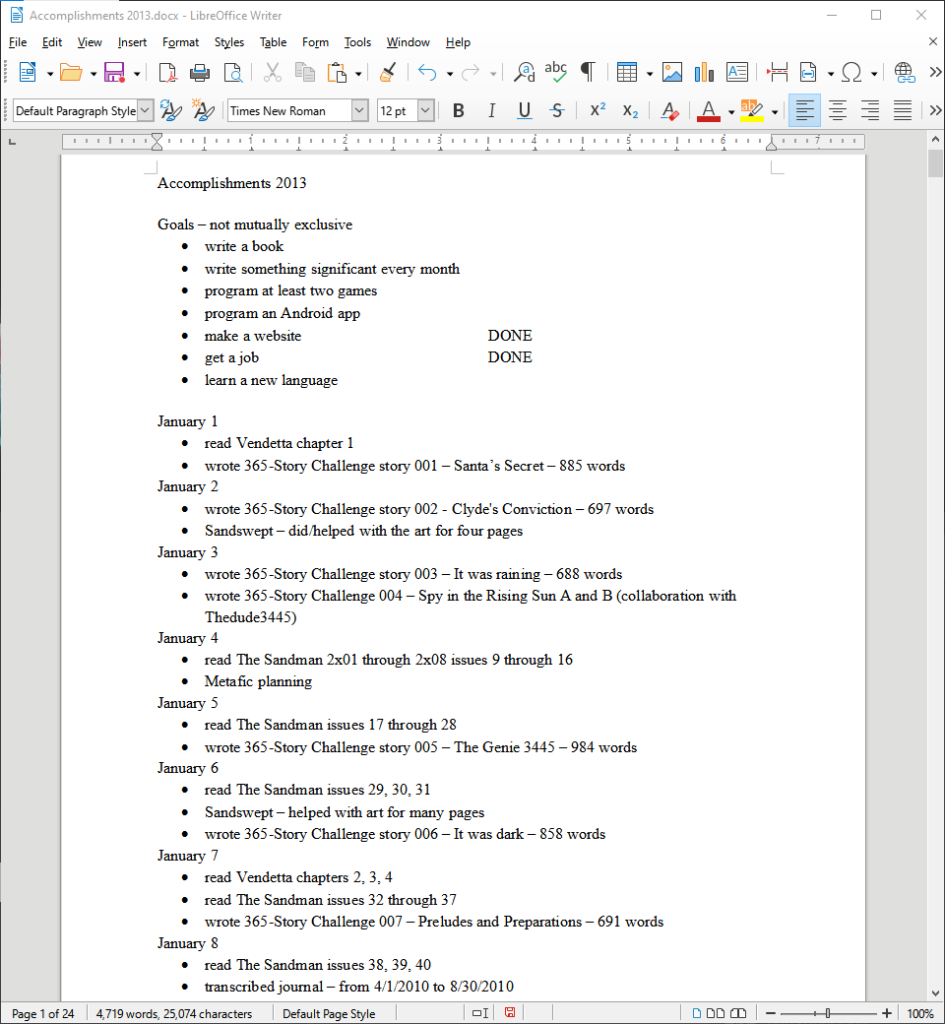
… Most of which I didn’t even come close to finishing.
This is probably common knowledge, but I need to say it anyway: New Year’s Resolutions suck. They’re a terrible way to get things done; they’re reliably unsuccessful; they’re the laughingstock of the self-improvement world for a good reason. You can’t just set a goal for yourself with a deadline of “a year from now” and expect yourself to work toward it in any real way, without any kind of game plan except for where you want to end up.
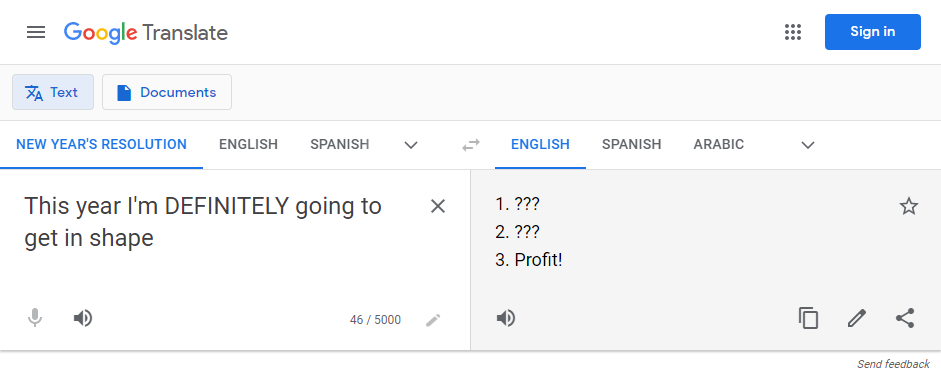
So looking back at these 2013 goals of mine, I’m not surprised that I failed most of them. Just making a website (which I kind of did by default by being in a web development class) and getting a job (which I kind of had to do because I finished school).
But look at the daily accomplishments themselves! I was actually writing! Every day, even! I started my year off strong.
… And then the daily writing trailed off after a month, just like 99% of all habits that start on January 1st.
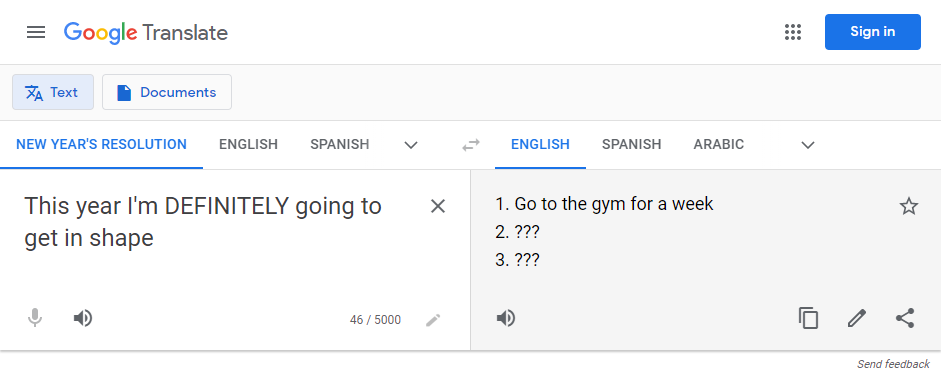
But again, I managed to keep up the daily doings tracking for the entire year. And skimming through the file now, eight years later, I think I did pretty good! More creative project progress days than in 2012, at least. But I was still far from being the consistently “productive” producer of creative content that I wanted to eventually become.
The streak finally ended in late 2014, when I stopped bothering to update Accomplishments 2014.docx after a few weeks of doing especially little of anything. (And also, because I was severely depressed at the time. Don’t worry—I got better eventually.)
The Monthly Resolutions Era
I didn’t get back onto the productivity tracking train until January 2017. My depression was long behind me, my mental/emotional energy levels were at an all time high, and I was becoming increasingly antsy over my lack of creative progress in recent years.
I was motivated by a fear—that decades down the line, when I’m at the end of my life, I’d look back on everything I ever did and regret it all because I still never became a writer. That I’d never finish (or even start) writing all those novels I wanted to write, and then I’d realize I had run out of time. I didn’t want to be the person who spends years thinking about when my life would truly start. It had already started. I had already lost years.
It was a buildup that happened over a few weeks, and all the circumstances were aligning in exactly the right way for me to make a big change in my life—especially because the new year was right around the corner.
Okay—I know I said New Year’s Resolutions are unreliable and worthless, but they’re just so tempting. I love the idea of a commitment that starts on Day 1 of the year and ends at the end—it’s just so clean (in a totally fake, obsessive-compulsive sense, but still).
Besides, I had an ace up my sleeve this time: my resolutions would only last a single month.
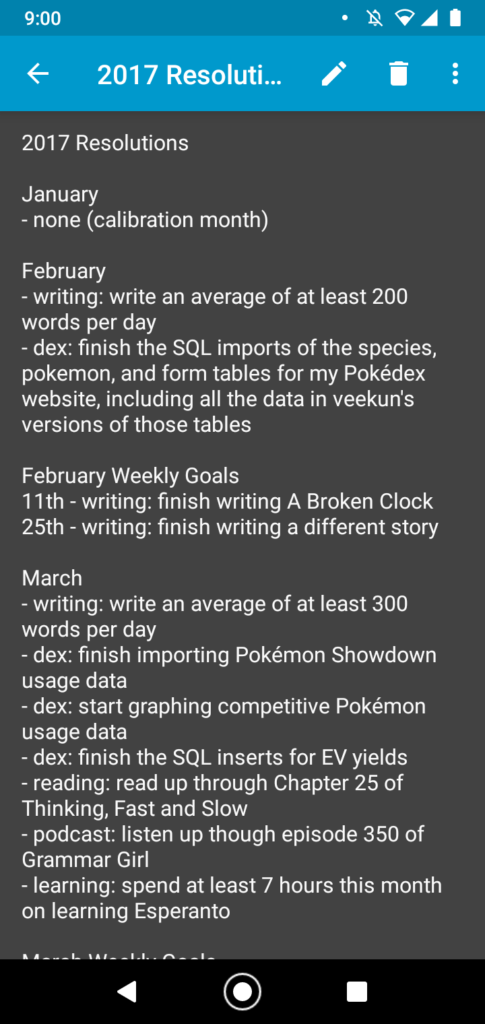
In the last few days of every month, I would define my goals for the next month from a handful of different categories of projects: writing, software development, language learning, reading, more writing, other media consumption, and some others. I skipped January for the sake of it being a “calibration month” (why set monthly goals before you know how much you can do in a single month?) and then I got to work, doing big projects one month-sized chunk at a time.
This process was massively successful for me—out of the 75 monthly or weekly goals I set for myself over the course of 2017, I completed 63 of them by my self-appointed deadline! Who would’ve thought that setting reasonable goals with reasonable deadlines would make all the difference?
(In the screenshot above, you can see when I wrote A Broken Clock, a short story I’ve posted previously on this blog. The “dex” project is Porydex, my competitive Pokémon usage stats tracking website. I’ll probably post about that project in the near future.)
At the end of every month, if I hadn’t finished something, I would add a big old “ – FAILED” next to it in the list. I didn’t have to do that until June, with my perhaps-too-directionless goal of “plan and outline stories for at least 10 hours.” But that failed goal opened the floodgates to many other failed goals over the second half of the year—mostly for the same few projects that continually failed to get off the ground.
But the basic formula of monthly resolutions worked so well that I kept it going for all of 2017, and then for all of 2018 (with mostly the same document formatting, so no need for another screenshot here), and then for most of 2019—occasionally taking months off for “recalibration” or simply to rest, but even then I was happy with how much I was getting done… mostly.
Eventually, flaws became apparent with this system. Even though it was better than a full year, a month was still too far out to plan some goals—I’d go 2 or 3 weeks without working on something yet, thinking I had all the time in the world to get to it, and then oops no I didn’t. Also, it’s just hard to calculate how much you can fit into an entire month. Sometimes I wildly underestimated, sometimes I wildly overestimated.
If only there was some kind of middle ground, perhaps based on an extremely detailed tracking methodology that software developers are known to use…
The Sprintlog Tasklog Era
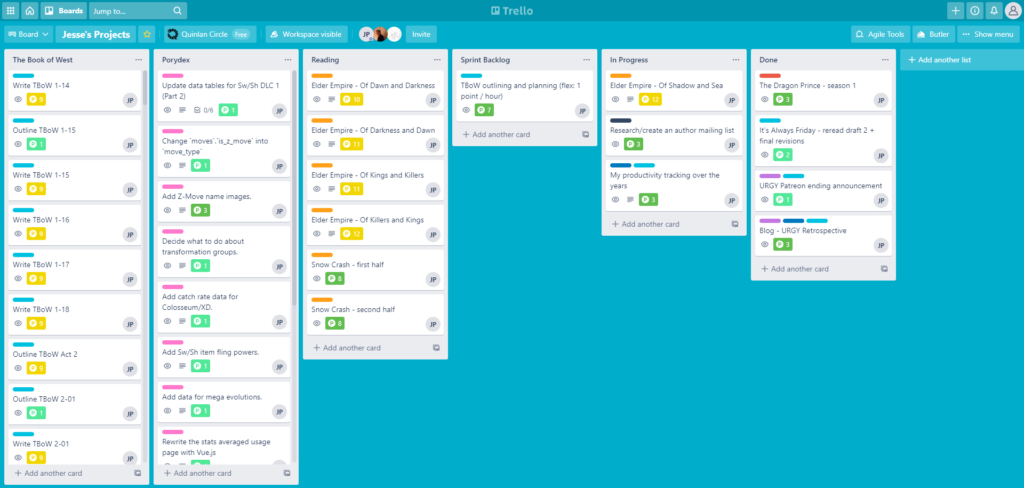
Enter Agile sprints.
I broke down all my active projects into dozens of tasks and subtasks, each of which were independently sized as being worth a certain number of “points.” (To keep things simple, I started out with a “small/medium/large” paradigm of tasks worth 1, 3, or 9 points.) All of these tasks now formed my project backlogs.
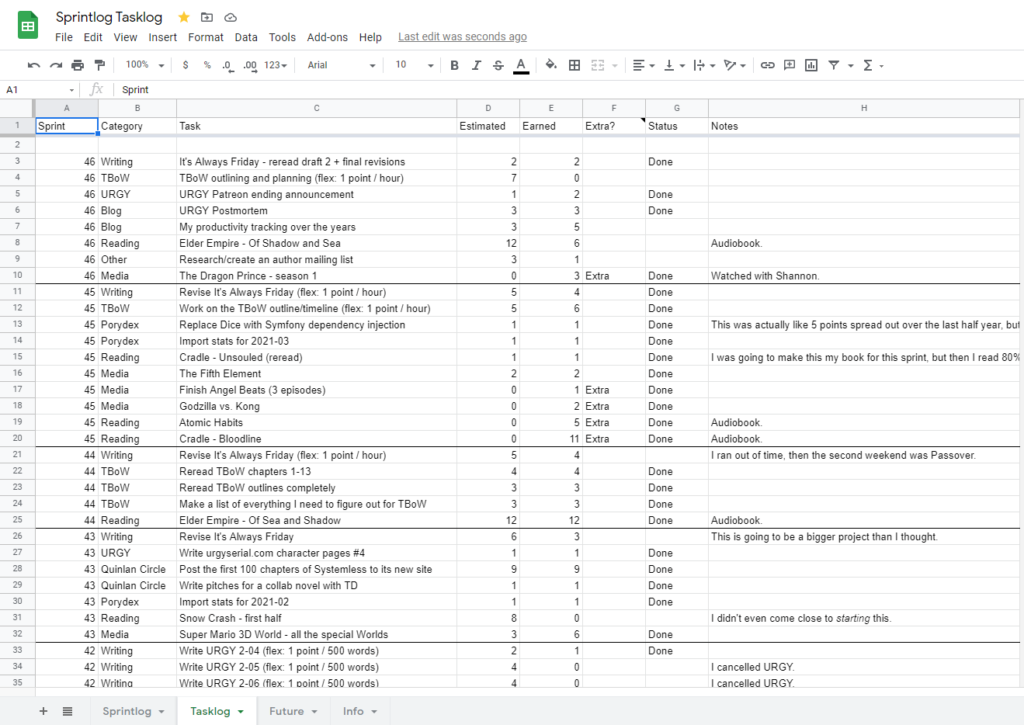
I would work in two-week sprints. Every two weeks, I would pick tasks from the project backlogs to work on in the next sprint. How many tasks? As many as I know I can do, based on how many “points” I’ve tended to complete in previous sprints. (The first sprint is a total guess, another “calibration” time period. Every sprint after that is an iterative process of nailing down exactly how much I can do in a single two-week period.)
As I complete tasks, I earn the points. Then two weeks later, the process begins anew.
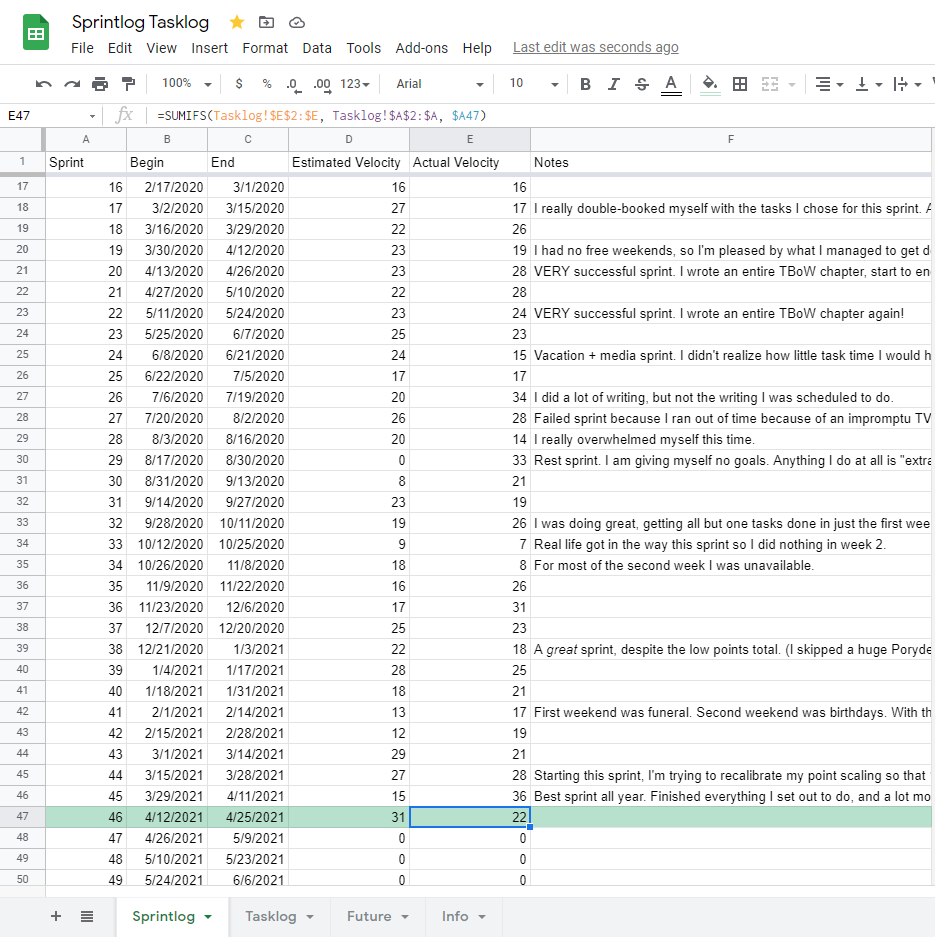
When I started this process, I mainly used trello.com to keep track of my backlogs, with the Agile Tools by Corrello plugin to add point sizing to my tasks. Over time, I’ve transitioned more into using the “Sprintlog Tasklog” Google Sheet that I originally made for historical points-tracking.
This is it—the process that finally got me to consistently work on all my projects, rigorously enough to know exactly how much I could schedule for myself, how far in advance I could try to schedule myself, and made it abundantly clear when a specific project was taking longer than expected. (Or when a specific project was consistently not being worked on, despite slotting it in multiple times—in which case, I guess I don’t really want to do that thing after all, and I should stop trying to force it.)
It isn’t a perfect process. Dividing your life up like this makes it feel like an endless grind, which can get pretty overwhelming at times. You become aware that you always have months/years worth of items remaining on your to-do list, and you can only cross them off one week at a time.
But if you have long-term goals like writing novels, developing indie games, drawing comics, teaching yourself a foreign language, or any other kind of big project… Your to-do list is already that long.
I doubt that my Sprintlog Tasklog is going to be the last iteration of productivity tracking I ever use—I’m only 2 years into it, after all, and both of the earlier eras ended in year 3. I know there are further improvements I can add to my process. (Like actually following the advice in those productivity self-help books, for one thing. Forming better habits, cutting down on social media time, etc.) But right now, I’m just content to be getting things done.
This post has a sequel now! Read it here: https://www.jessepirnat.com/blog/sprint-system-retrospective